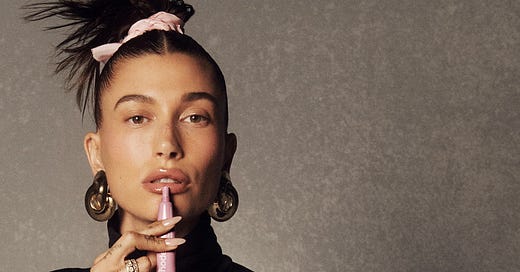The Rhode map of beauty marketing: 4 marketing strategies and what's next
The business of Hailey Bieber's beauty business.
Rhode is barely three years old, yet it’s one of the most observed — and scrutinised — beauty brands of the moment. From viral sellouts to a signature aesthetic that’s instantly recognisable, it’s a true direct-to-consumer success story at a time when DTC beauty has lost much of its early-2010s shine.
Online, Rhode feels big. It dominates feeds, sets trends, and sells out within minutes. But in the wider beauty industry? It’s still a small player. That may soon change. With rumours of a move into wholesale distribution (Puck’s Line Sheet has reported that it’s going to Sephora in the US), Rhode is on the brink of something bigger — access to more customers, a shift in positioning, and potentially, a new chapter in its brand evolution.
So, how exactly did Rhode get here? This deep dive focuses on the marketing and creative strategies that have set it apart. It’s polished and well thought out and has really propelled sales of product that is, well, according to a lot of people in terms of efficacy… fine? I have a few products which I like but I wouldn’t say they were makeup bag must-haves.
Hailey Bieber has been clear from the start that she’s invested her own money in this, but she’s not doing this alone. Rhode’s strength lies in its curation, from the tight product edits to the expert advisory board she’s assembled. And if there’s one thing Rhode gets right, it’s knowing exactly how to capture (and hold) attention.
Strategy 1: Skincare Positioning at Launch
Let’s be honest: Hailey Bieber was technically a model, but she wasn’t exactly walking every major runway like Gigi Hadid or Kendall Jenner. Before Rhode, she was best known for her last name (Alec Baldwin’s niece) and then, of course, as Justin Bieber’s wife. A level of fame, yes, but not quite the built-in celebrity of a supermodel.
So how does she rebuild her reputation?






